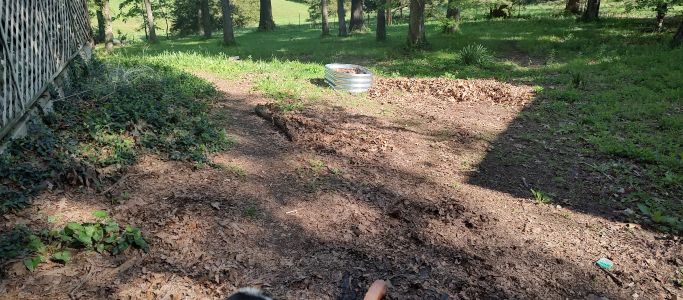Good morning! I hope everyone is having a wonderful spring. This is the time of year where we think about what we would like in our garden. It may be produce plants, flowers, herbs, or succulents. Whatever the case, we have many factors to consider. What are the needs of the plants? Which plants can be planted next to each other? How much space do I have to dedicate to these plants? Are there terrain considerations such as hills, rocky soil, water runoff from nearby terrain? Today, I'm going to highlight some specifics from our own yard and incorporating some tactics we've used in the past that address what to do with fallen limbs and leaves from last fall, making them an important consideration for both your garden and your yard. And bonus, less you have to move to a yard waste recycling center or burn. You can simply use them in your own garden!
First consideration, you might have noticed that this site is from SW Missouri. We have hills, rocky soil, and lots of trees. Lots of trees means lots of leaves in the fall and branches/limbs breaking during storms. The rocky soil makes it difficult to work the ground into a garden without adding significant amounts of either filtered top soil (removing rocks through a grate system) or some other store bought soil. I'm generally not a fan of this because of the amount of work involved. One solution my husband and I have used is to incorporate raised beds (not raised up on legs). You might thing that also requires soil. Yes, it does! However, remember that there are also tons of leaves and broken branches available. What we like to do is build or use an open bottom raised bed. After placing that in an area that gets the appropriate amount of sunlight (we have to take into consideration trees still leafing out and reference where the most light was last year) we level it as needed (make use of those rocks) and start layering our garden bed. The first layer is those branches and leaves from around the yard. This step can be done in the fall allowing composting throughout the winter or you can begin it in the spring. Either way works and next year you can continue building on this. After filling your raised bed at least half full of leaves and branches (we prefer a little more because the leaves and branches will compress as they compost and are compressed by soil and water) add your soil.
Here's the benefit to this set up. As the bottom materials compost, they become soil. Their nutrients feed the plants. The plants roots will naturally grow into the composting material. If those plants happen to be deep rooting, the open bottom to the raised bed allows those roots to grow into the ground. This limits issues with root bound plants and stunted growth. Additionally, next year you will have even more soil from the composting material. You will probably also have more leaves and limbs in your yard but, those can be added to your bed to supplement the soil.
Now for some backstory...A few years ago we wanted to grow a garden because we both missed having fresh vegetables. We were very low budget at the time and took advantage of several factors available at the time. We recycled wooden pallets to first build the raised beds. Finished it off as a greenhouse with some semi clear plastic sheeting stapled to a frame. We filled the raised beds just as described above. I'm pretty sure we did this part before building the greenhouse around it. Then we added the plants and let it grow. After the heat of summer came on, we removed the plastic covering (rolled up and put away). Then the pesky squirrels started raiding the crop. We added chicken wire to protect our crop. We learned a lot from the experience and enjoyed the veggies and herbs.
Every situation is unique and I hope you gained some inspiration and ideas from this. Happy gardening!

